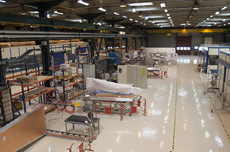Layering detection: CMS gets an upgrade
 |
In this factory at CERN, collaborators from all over the world work to put together the chambers that will be used to track muons in the CMS detector. Photo: Anaïs Schaeffer, CERN |
The CMS upgrade is under way at CERN. With the help of several international collaborations, including Fermilab, the Compact Muon Solenoid detector should have a fourth layer of muon detection chambers installed by the start of 2014.
This layer, composed of cathode strip chambers, will be used to follow the path of muons even farther than before.
"The CSCs in the first three layers are performing very well," said Giorgio Apollinari, head of Fermilab's Technical Division and previous CSC construction manager. "We determined that adding a fourth layer was the most appropriate upgrade for CMS. We want to be able to track the path of muons longer, improving our measurements of their momenta with reduced background tracks."
Scientists study the muon, a heavier cousin of the electron, to see how subatomic particles interact and decay. A muon couples with other heavier particles much as an electron does. With its larger mass, the muon travels nearly undisturbed through steel and iron, while the matter absorbs electrons and particles produced in CMS collisions. This feature makes the muon an ideal probe for scientists to study the decay of heavier particles, such as those produced by the decay of a Higgs boson.
In an immaculate factory on the French side of the CERN campus, scientists, technicians and engineers from Beijing, St. Petersburg, the United States and CERN itself are assembling the chambers using the same tools and equipment that were used for the original CMS production of cathode strip chambers at Fermilab. Using precise care and following rigorous safety and quality protocols to prevent damaging any of the pieces, they plan to complete half of the chambers needed for the fourth layer by the end of this year. That's 36 chambers, each comprising seven copper panels.
"We already have about 470 chambers working and taking data for the CMS experiment," said Armando Lanaro, CSC construction coordinator at CERN. "This fourth detector layer will add redundancy to the existing tracking."
The CSCs have grooves etched along the length of each panel. Perpendicular to the grooves, wires thinner than a human hair span the panel's width. The grid pattern allows the detector to track muons as they form from an initial proton-proton collision in the center of the detector and eventually decay into other bits.
"Once the fourth layer is in place, the detector will be what we originally planned to build," Apollinari said. "The original design worked so nicely, and the chambers were designed so well, we just want more."
The copper panels that make up the chambers' skeleton are procured through private companies before they are cut into the proper shape at Fermilab. Fermilab technical staff members also engrave the panels.
"All of the panels need to have strips engraved into them to provide the second coordinate," Lanaro said. "Fermilab does the milling. It's really an artwork."
Once the panels are engraved with independent strips and shipped to CERN, they are wrapped with a gold-coated tungsten wire that is 50 microns thick. Wound continuously over four hours, the wire measures about 2.6 kilometers in length and creates 1,000 strands on each side, each tensioned to 250 grams. A machine built by Panasonic specifically for this purpose solders the wires to a strip lining the edges of the panel. It takes six-and-a-half hours to solder all 4,000 joints. Technicians attach electrical components to each joint, and the wire is cut at each junction to make 2,000 independent strands (1,000 on each side of the panel).
"After it's all put together, we test it," Lanaro said. "It has to be clean, without any dust. If it's not clean, it could cause a background event and hide a real signal."
Read more
—Ashley WennersHerron
|